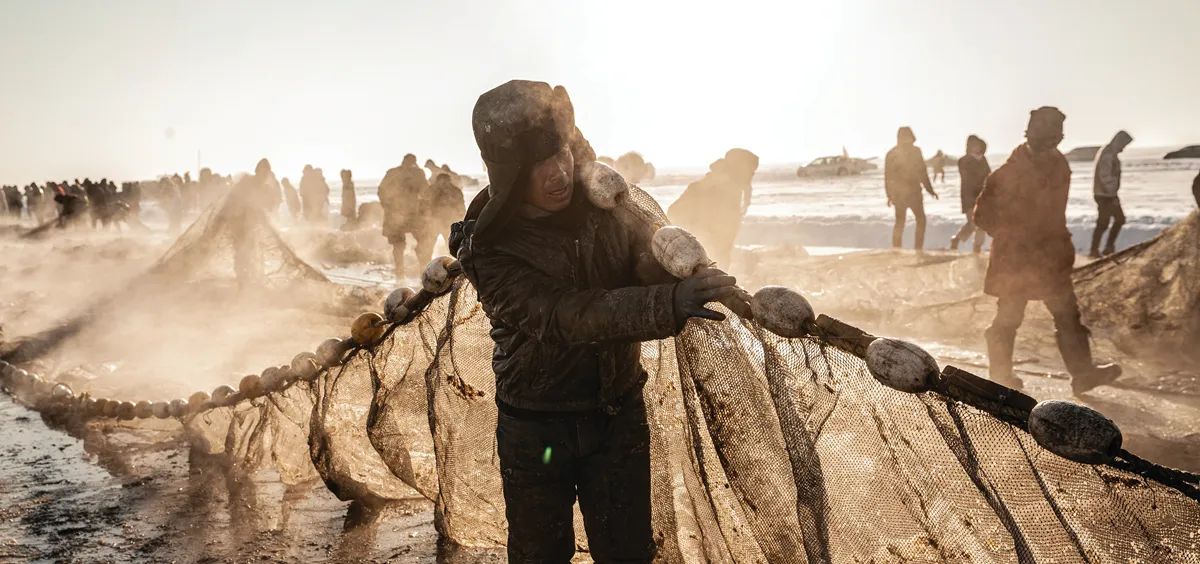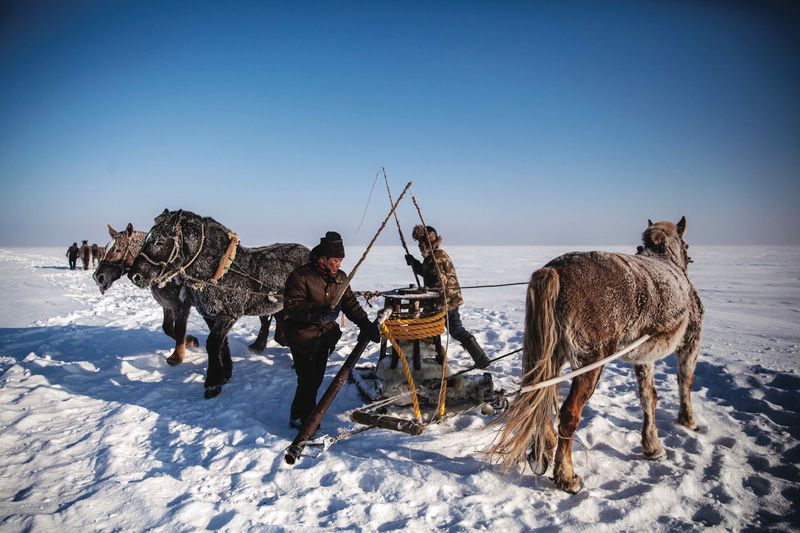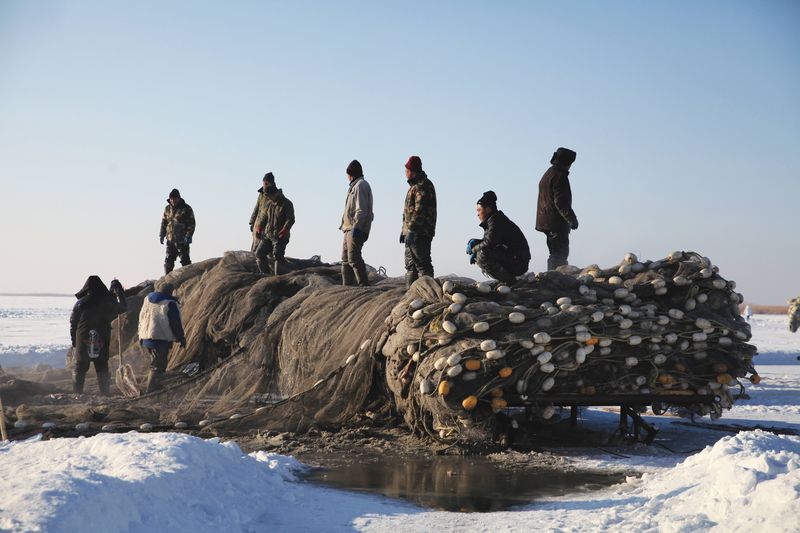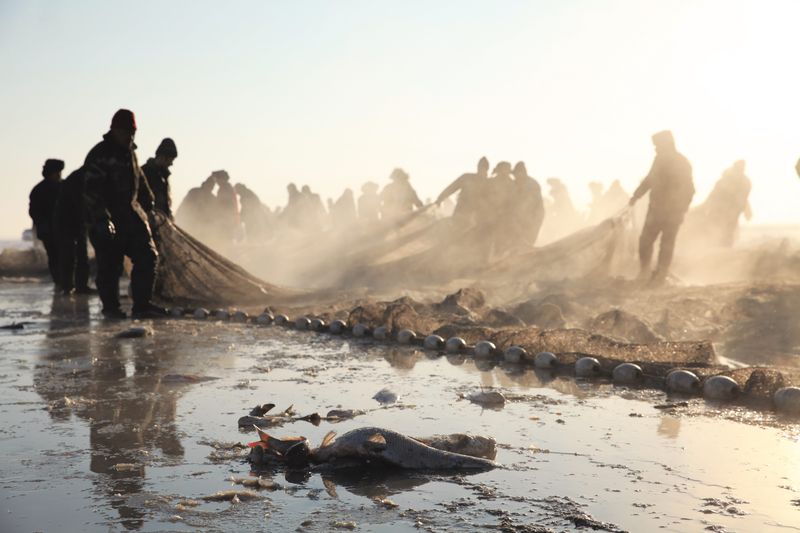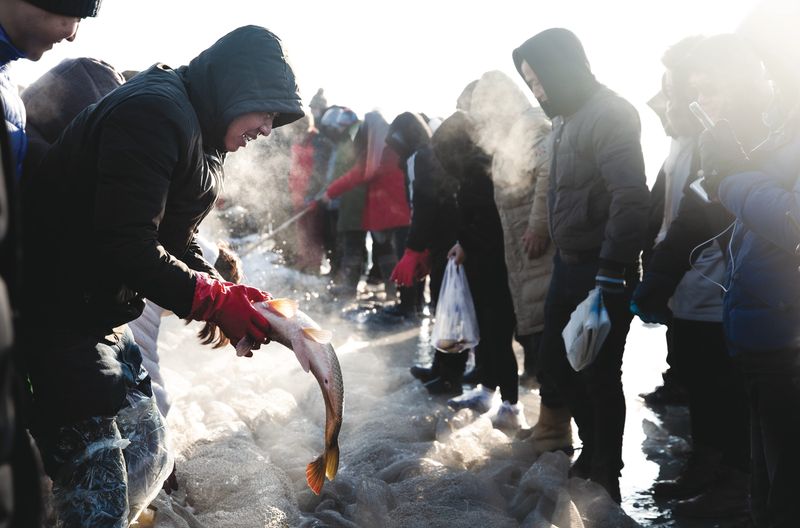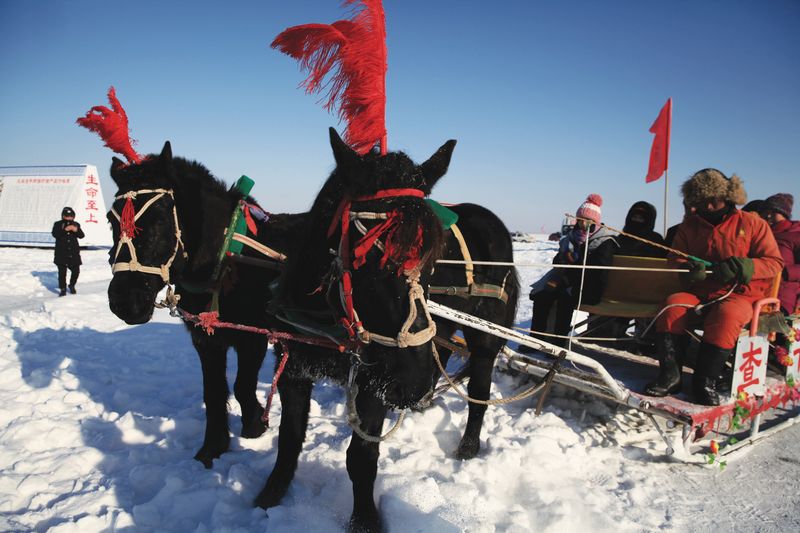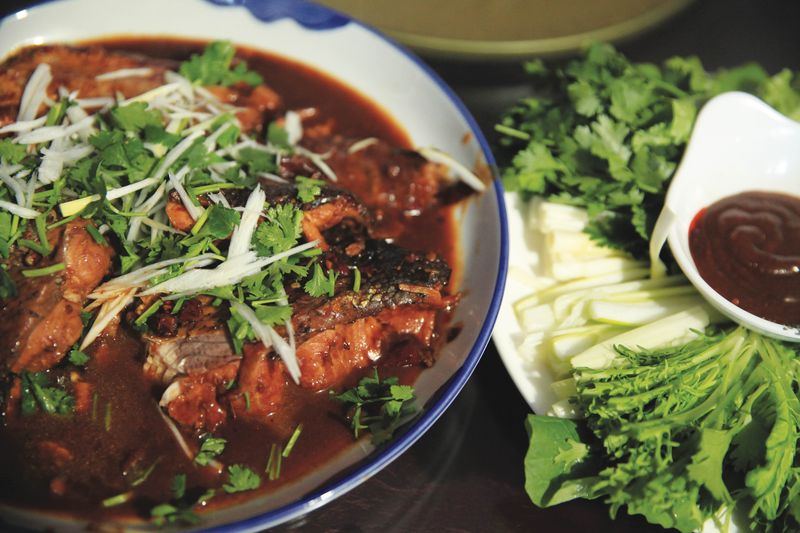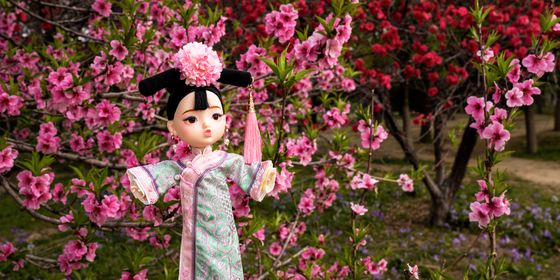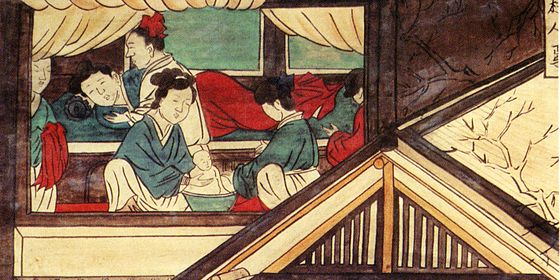The annual “winter catch” at Chagan Lake revives a millennia-old fishing tradition as a cultural spectacle
Under the purple twilight, a sleigh pulled by a dozen horses soars over untouched snow; running parallel, head fisherman Zhang Wen’s secondhand Subaru forges through the fog. His flashlight dances into the darkness, searching for the red flag marking where his team left their net the previous night.
“So, when will we get to the lake?” I ask our driver Mr. Wang, who plants rice from late spring to early autumn, then ferries tourists in winter when his fields are covered in snow.
“We’ve been on top of the lake for the last five minutes!” announces Wang, his hands nimbly shifting the steering wheel into a sharp turn, still in hot pursuit of the fishermen. Beneath the frozen blanket of white stretching horizon to horizon, there is no telling where the ground ends and the lake begins.
In a motorcade of cars and horses, over 50 fishermen navigate tracks diverging in over a dozen different directions. Making a hairpin turn, one old car sputters out in a snowbank, and everybody is out, pushing and cursing. No good; it’ll need to be towed. The driver hops into a friend’s vehicle. It is minus-27 degrees Celsius. The mucus freezes in our nostrils.
Equal parts romanticism and reality, Chagan Lake (“White Sacred Lake” in Mongolian) in China’s northeastern Jilin province boasts a prehistoric tradition of ice fishing that tourists can still witness today. We’ve risen before dawn to join a squadron of fishermen as they go about their daily winter routine of pulling a 2,000-meter-long net under the surface of the ice.
For millennia, this 420-square-kilometer lake in the Qian Gorlos Mongolian Autonomous County, over 200 kilometers from the provincial capital of Changchun, has been venerated for its plenitude and sacredness. In the Liao (907 – 1125) and Jin dynasties (1115 – 1234), emperors used to host banquets of roasted carp on Chagan’s shores to entertain their ministers. Legend has it that Genghis Khan burned incense by the lake in 1211 after conquering the surrounding territory. In 2018, President Xi Jinping stopped at Chagan during a tour of the northeast, crediting the local government’s stewardship for the lake’s environmental regeneration.
As ecotourism and cultural tourism become vogue industries, Chagan fishermen’s winter catch has been declared one of the “Eight Natural Wonders of Jilin” and an intangible cultural heritage by the provincial government, making it a new attraction on the itineraries of travelers in China. As tourists come, so do the billboards. A red sign looms large over the lake’s edge with the singular endorsement: “General-Secretary Xi visited Chagan Lake.”
Driving about town, one sees walls and windows plastered with reproductions of Xi’s 2005 slogan, “Green waters and verdant mountains are gold and silver mountains.” Equating ecological health to financial wealth seems to have been a step in the right direction for Chagan Lake, whose recently restored ecological prosperity has brought fresh financing to the ancient fishing communities along its shores.
As the dawn pales into a bottomless blue, a fisherman raises a wooden drill into the air, gripping the handles tightly with both hands, and thrusts it downward with practiced strength.
The ice shatters into slush, and a gaping wound opens into the obscure depths. For a second, I’m afraid the entire sheet beneath will splinter and swallow us whole.
An elaborate opera of ice, steel, and rope grinds into motion, orchestrated by horses and men. First, the fishermen plant metal turnstiles which, rotated with the strength of two or three horses, extends the vast net underwater toward the next hole. The men then drive their horses in constant circles around the axis, which stands like a winter maypole under the cloudless sky.
This choreography goes on for hours: the men shout, the whips sing, the horses pant, and ice cracks as the net slithers, octopus-like, beneath the ice. Zhang Wen, the head fisherman or batou, lumbers across the snow, waving, shouting orders to groups of men, and moving flags to signal the locations and timing of the setting and raising of the net.
“Not everyone can be a batou,” says Zhang. “You need to master technique and management, and be responsible for everyone’s safety. With four nets, we need to get 300,000 jin [150,000 kilograms] of fish up before the Lunar New Year for the whole country to eat.”
“The responsibility is great. It’s a hard job, but when the fish come out, it’s a happy thing,” says Zhang. “You don’t feel tired anymore.”
For over 30 years, Zhang has risen at 5 every morning during the December to early February ice-fishing season. Zhang’s biggest ever catch, which included one net weighing 168,000 kilograms, set a Guinness World Record in 2008.
“People ask us why we use such old technology. Sure, we could use modern tools: electric drills, machines instead of horses,” admits Zhang. “But we are doing it in a traditional way. We could catch way more fish than we do, but we purposely catch much less.”
Chagan’s fishermen are not compensated for their haul so much as their roles. Their fishing grounds are a state-owned enterprise, where independent fishing—that is, fishing without an expensive license—is banned. The region was designated a provincial natural reserve from 1986, and a national natural reserve since 2007.
Today’s fishers receive a state subsidy of 120 RMB a day, 320 RMB for batou. The realization has dawned around town that there is more money to be made in tourism than catching carp.
“If they fished here with modern tools, would anyone come to see it?” one visitor points out. A native of Chagan, his family has since moved to an apartment in nearby Songyuan city that is “so modern, it doesn’t even have a kang,” he says, wistfully remembering the traditional hearth at the center of northeastern homes. Once a year, he returns to the ice for a dose of nostalgia.
The fishermen are aware that their work is, in some part, a show. “If you add one more day, we’re out of here,” one worker grumbles to Zhang. The fishing season, which typically ends seven days before the annual Lunar New Year holiday, was given a last-minute extension this year to accommodate the shooting of a TV special.
“It’s not up to you,” Zhang grumbles back. Having been named the “20th-generation inheritor” of the local ice-fishing batou position, Zhang now includes posing for cameras in his job description. Before a swarm of lenses, he dutifully shovels chunks of ice from the edge of a hole onto an adjacent heap, unsure of which are media crews he’s expected to cooperate with, and which are enthusiastic tourists. Someone asks him to move a little so they can get a better shot.
By late morning, their nets lowered without a hitch, Zhang and his team huddle in their workers’ cabin, a wooden trailer brought along on wheels, boiling dumplings and instant noodles. Their flanks drenched in sweat, the horses dig their snouts into nosebags of fodder; leaning in close, I find their long eyelashes encrusted with ice.
In the early afternoon, we join a thickly bundled audience crowding around the two-kilometer-long net slowly churning out of the lake. The anticipation is palpable; we bounce up and down to keep the feeling in our toes. Steam rises from the nets into golden mist, through which gradually emerge mussels, catfish, and all shapes and sizes of carp.
Finally, a pangtou (“fat head”) carp flops onto the ice—and then another. Visitors yelp and lunge for the carp with their mittened hands. We quickly find that the scrimmage takes some technique—more than once, a flailing fish wriggles free from the grips of one hand and is quickly snatched up by another in the free-for-all. When bags are full, visitors lug their haul to the pay-by-weight station, and hop back into their cars, driving off with their dinner still flopping inside the trunk.
That evening, our homestay host Wang Fengyun holds a pangtou—the head of which alone weighs 5 kilograms—steady by the gills as her brother cleaves it down the middle with a kitchen knife. Soon, the fish is bubbling in a large wok over a wood fire. When it comes out of the kitchen, doused in a thick and hearty brown sauce with sides of spring onion and lettuce, it’s enough to feed an entire family from Songyuan staying in Wang’s home.
In 2008, the lake began to auction-off its largest pangtou carp in the “first catch of the winter” ceremony of the Chagan Lake Ice and Snow Culture Festival, part of a tourism initiative to mark the beginning of the fishing season.
In its first year, the festival’s ceremonial pangtou was auctioned off for 11,099 RMB (1,599 USD) to a food factory. This winter’s first pangtou, weighing 17 kilograms, fetched 2.93 million RMB (422,671 USD). In a little over a decade, the ceremonial fish’s value had grown nearly 300-fold.
What began as a bid to attract cultural visitors has become increasingly embellished: “The ceremony is based on the Liao dynasty practices such as honoring the lake, honoring the net, and shouting across the ice,” explains Shan Junguo, the Party committee secretary at Chagan Lake. “Then we added Mongolian cultural elements, like song, dance, and drinking ritual alcohol.” Meanwhile, older local fishermen don’t recall any such festivities from their youth.
“Have you ever seen the ceremony?” I ask our driver Mr. Wang.
“Of course not—it’s the busiest time of year for us!” he replies.
Perhaps one reason for Wang’s apathy is that the time-honored routines of Chagan’s fishermen are now more spectacle than necessity. The fish, we learn, are transplanted from a nearby farm. Every spring and autumn, groundsmen slip a million sprats into Chagan Lake.
While regulations stipulate that these baby fish must be no longer than 8 cun (about 30 centimeters), local skeptics mock these “bathed fish” as merely farmed produce given a short bath in fresh water before being marketed as “lake fish.”
Then again, nobody wants to see the backstage of Disney World, where Mickey Mouse removes his head, either.
The pageantry may be controversial, but the reality of Chagan’s former decline and recent regeneration seems to be undisputed.
When we arrive at head fisherman Zhang’s home, he greets us at the gate, as two small white dogs circle at his feet. In a simple wool vest, stripped of the severe fur and leather trappings of the batou, Zhang looks almost grandfatherly. He dons reading glasses and gently ushers us over the tiled floors and onto his kang.
Zhang tells us that, when he was a child, Chagan Lake almost disappeared.
In the 1950s, a reservoir was built on the Songhua River upstream of the lake, choking off Chagan’s water source, and causing it to shrink dramatically from 500 square kilometers to just 50. For years, villagers called the remaining pool of water the “Chagan Pond,” or “Drought River.”
“[The 1960s] were difficult,” Shan explained. “Every spring, white sand [storms] would cover the entire area. People drove three-wheeled rickshaws, there was not enough grain; our stomachs were never full. We wanted to get the water back.”
In a masterstroke of engineering, led by an irrigation specialist, the people of Qian Gorlos diverted water from another river to replenish the lake. “The entire county of 800,000 people participated, from students to housewives, to produce a new water channel from 53.85 kilometers away,” recites Shan.
On the ice, we meet Ma Yunjian, a local resident who now offers sleigh rides on the lake to tourists on her colorfully decorated carriage. When Ma’s father fished, he had to walk 7 li (500 meters) just to get to the lake, and dealt with frequent floods—in 1984, the floodwater came up to his family’s door’s edge.
As a young woman, Ma sewed nets and helped pull them in every winter until she was married. “Back then, women in every family did it. We could make some 20 RMB a day,” she tells us. Ma says the nets used to be drawn in and folded entirely by local women, but now, as the catch is managed by lake officials, the fishing grounds only hire men.
The lake’s growing profitability, as well as protectionism, began in 1992, when Chagan officials borrowed 5.3 million RMB (721,292 USD) from the local agricultural bank to buy newly hatched silver carp, and enforced a three-year fishing ban on the lake while the fish matured.
When the lake reopened to fishing in 1995, Shan recalls, bank representatives would sit at the edge of the lake during fishing season hoping to recollect their debts, while schools allowed pupils to help with the dragnet.
In the years since, the fishing grounds have become an effective monopoly, enforcing both the ecological protection of the lake as well as controlling profits from the lake’s bounty. Wang, our driver, tells us there are currently two people sitting in the local jail for fishing without licenses.
Ma, with her horse carriage, is the last vendor on the ice this year. After the authorities began requiring a 5,000 RMB (721 USD) annual license to operate a small business in the “scenic area” beginning last year, vendors who sold steamed buns, hot potatoes, and freshly barbecued fish to tourists have reconsidered their profit margins and closed up shop.
A few meters away, a 60-year-old local woman surnamed Yu scoops up a few small, scraggly fish with her granddaughter, but when a fishing ground employee tells her she has to pay for them, she dumps them all back onto the snow. “When we were young, we could fish at will, though there was so little water it was difficult to eat our fill,” she grumbles.
“I’ve thought about starting a restaurant, but there’s no room for us,” Yu adds. “The ones that open make a lot of money, but not anybody can open one. You need to know the leaders, have guanxi.”
Nevertheless, the renewed fishing and growing tourism industries brought wealth that has transformed the village entirely. Modern single-family homes have replaced duplexes made from thick mud-brick walls, and fisherman Zhang has built a second house as a homestay. “No fish, no tourists,” he concludes.
The nets of Chagan may still bring giant freshwater fish, but tourists remain the bigger catch. More difficult to lure, these complicated creatures follow the currents of cultural legends and performative reenactments of primeval rituals. But they will always find a hospitable environment, says Ma.
“The only thing is, you can’t build multi-story buildings,” she adds with a chuckle. “We want to be China’s most beautiful fishing village.”
Photography by Tina Xu
Of Ice and Men is a story from our issue, “Grape Expectations.” To read the entire issue, become a subscriber and receive the full magazine.





